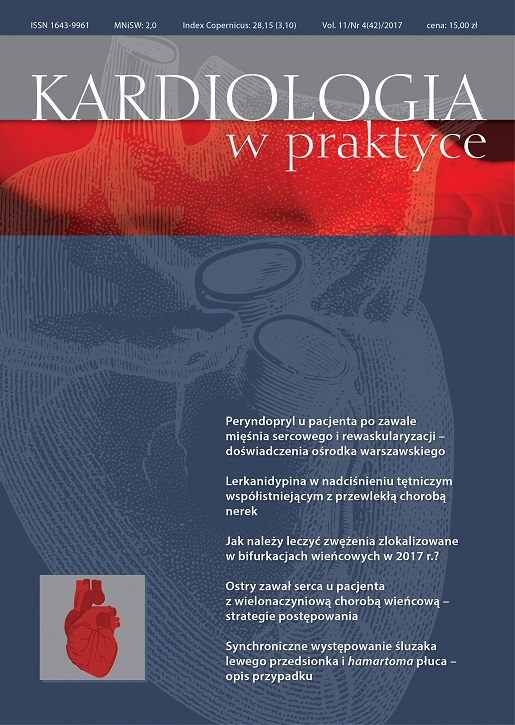Lercanidipine in hypertension coexisting with chronic kidney disease Review article
Main Article Content
Abstract
Risk factors modification significantly improves prognosis in patients with cardiovascular diseases. In hypertension treatment nephroprotective drugs are important. They increase glomerular filtration and reduce proteinuria.
Downloads
Article Details

This work is licensed under a Creative Commons Attribution-NonCommercial 4.0 International License.
Copyright: © Medical Education sp. z o.o. This is an Open Access article distributed under the terms of the Attribution-NonCommercial 4.0 International (CC BY-NC 4.0). License (https://creativecommons.org/licenses/by-nc/4.0/), allowing third parties to copy and redistribute the material in any medium or format and to remix, transform, and build upon the material, provided the original work is properly cited and states its license.
Address reprint requests to: Medical Education, Marcin Kuźma (marcin.kuzma@mededu.pl)
References
2. Romundstad S., Holmen J., Kvenild K. et al.: Microalbuminuria and all-cause mortality in 2,089 apparently healthy individuals: a 4.4-year follow-up study. The Nord-Trøndelag Health Study (HUNT), Norway. Am. J. Kidney Dis. 2003; 42(3): 466-473.
3. Salmon A.H., Ferguson J.K., Burford J.L. et al.: Loss of the endothelial glycocalyx links albuminuria and vascular dysfunction. J. Am. Soc. Nephrol. 2012; 23: 1339-1350.
4. Vanholder R., Massy Z., Argiles A. et al.; European Uremic Toxin Work Group: Chronic kidney disease as cause of cardiovascular morbidity and mortality. Nephrol. Dial. Transplant. 2005; 20(6): 1048-1056.
5. Foley R.N., Murray A.M., Li S. et al.: Chronic kidney disease and the risk for cardiovascular disease, renal replacement, and death in the United States Medicare population, 1998 to 1999. J. Am. Soc. Nephrol. 2005; 16(2): 489-495.
6. Tykarski A., Narkiewicz K., Gaciong Z. et al.: Zasady postępowania w nadciśnieniu tętniczym – 2015 rok. Wytyczne Polskiego Towarzystwa Nadciśnienia Tętniczego. Nadciśnienie Tętnicze w Praktyce 2015; 1: 1-70.
7. Robles N.R., Ocon J., Gomez C.F. et al.: Lercanidipine in patients with chronic renal failure: the ZAFRA study. Ren. Fail. 2005; 27: 73-80.
8. Dalla Vestra M., Pozza G., Mosca A. et al.: Effect of lercanidipine compared with ramipril on albumin excretion rate in hypertensive Type 2 diabetic patients with microalbuminuria: DIAL study (diabete, ipertensione, albuminuria, lercanidipina). Diabetes Nutr. Metab. 2004; 17: 259-266.
9. Leonetti G., Magnani B., Pessina A.C. et al.: Tolerability of long-term treatment with lercanidipine versus amlodipine and lacidipine in elderly hypertensives. Am. J. Hypertens. 2002; 15: 932-940.
10. Burnier M., Gasser U.E.: Efficacy and tolerability of lercanidipine in patients with hypertension: results of a Phase IV study in general practice. Expert Opin. Pharmacother. 2007; 8(14): 2215-2223.
11. Borghi C., Prandin M.G., Dormi A., Ambrosioni E.; Study Group of the Regional Unit of the Italian Society of Hypertension: Improved tolerability of the dihydropyridine calcium-channel antagonist lercanidipine: the lercanidipine challenge trial. Blood Press. Suppl. 2003; 1: 14-21.
12. International Diabetes Federation, Diabetes Atlas, 7. edition, 2015 [online: www.idf.org/idf-diabetes-atlas-seventh-edition].
13. Sieradzki J., Grzeszczak W., Karnafel W. et al.: Badanie PolDiab. Część I. Analiza leczenia cukrzycy w Polsce. Diabetologia Praktyczna 2006; 7(1): 8-15.
14. Zalecenia kliniczne dotyczące postępowania u chorych na cukrzycę 2017. Stanowisko Polskiego Towarzystwa Diabetologicznego. Diabet. Klin. 2017; 3(supl. A): A25-A26.
15. UK Prospective Diabetes Study Group: Tight blood pressure control and risk of macrovascular and microvascular complications in type 2 diabetes: UKPDS 38. Br. Med. J. 1998; 317; 703-713.
16. Kostka-Jeziorny K., Tykarski A., Dzida G. et al.: Lerkanidipina – w leczeniu nadciśnienia tętniczego i jego powikłań sercowo-naczyniowych. Arterial Hypertension 2012; 16(4): 216-223.
17. Sabbatini M., Leonardi A., Testa R. et al.: Effect of calcium antagonists on glomerular arterioles in spontaneously hypertensive rats. Hypertension 2000; 35(3): 775-779.
18. Waszkiewicz M., Lewandowski J.: Lerkanidypina – wyjątkowy oryginalny lek hipotensyjny. Medycyna Faktów 2013; 4(21): 36-43.
19. Barrios V., Escobar C., Navarro A. et al.: Lercanidipine in an effective and well tolerated antihypertensive drug regardless the cardiovascular risk profile: the LAURA study. Int. Clin. J. Pract. 2006; 60(11): 1364-1370.

